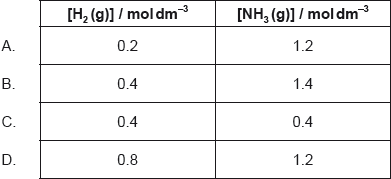| Date | May 2022 | Marks available | 1 | Reference code | 22M.2.hl.TZ1.3 |
| Level | HL | Paper | 2 | Time zone | TZ1 |
| Command term | State and Justify | Question number | 3 | Adapted from | N/A |
Question
Ammonia is produced by the Haber–Bosch process which involves the equilibrium:
N2 (g) + 3 H2 (g) 2 NH3 (g)
The percentage of ammonia at equilibrium under various conditions is shown:
[The Haber Bosch Process [graph] Available at: https://commons.wikimedia.org/wiki/File:Ammonia_yield.png
[Accessed: 16/07/2022].]
One factor affecting the position of equilibrium is the enthalpy change of the reaction.
The standard free energy change, ΔG⦵, for the Haber–Bosch process is –33.0 kJ at 298 K.
Deduce the expression for the equilibrium constant, Kc, for this equation.
State how the use of a catalyst affects the position of the equilibrium.
With reference to the reaction quotient, Q, explain why the percentage yield increases as the pressure is increased at constant temperature.
Determine the enthalpy change, ΔH, for the Haber–Bosch process, in kJ. Use Section 11 of the data booklet.
Outline why the value obtained in (b)(i) might differ from a value calculated using ΔHf data.
Demonstrate that your answer to (b)(i) is consistent with the effect of an increase in temperature on the percentage yield, as shown in the graph.
State, giving a reason, whether the reaction is spontaneous or not at 298 K.
Calculate the value of the equilibrium constant, K, at 298 K. Use sections 1 and 2 of the data booklet.
Calculate the entropy change for the Haber–Bosch process, in J mol–1 K–1 at 298 K. Use your answer to (b)(i) and section 1 of the data booklet.
Outline, with reference to the reaction equation, why this sign for the entropy change is expected.
Markscheme
✔
same/unaffected/unchanged ✔
increasing pressure increases «all» concentrations
OR
increasing pressure decreases volume ✔
Q becomes less than Kc
OR
affects the lower line/denominator of Q expression more than upper line/numerator ✔
«for Q to once again equal Kc,» ratio of products to reactants increases
OR
«for Q to once again equal Kc,» equilibrium shifts to right/products ✔
Award [2 max] for answers that do not refer to Q.
bonds broken: N≡N + 3(H-H) /«1 mol×»945 «kJ mol–1» + 3«mol»×436 «kJ mol–1» / 945 «kJ» + 1308 «kJ» / 2253 «kJ» ✔
bonds formed: 6(N-H) / 6«mol»×391 «kJ mol–1» / 2346 «kJ» ✔
ΔH = «2253 kJ - 2346 kJ = » -93 «kJ» ✔
Award [2 max] for (+)93 «kJ».
«N-H» bond enthalpy is an average «and may not be the precise value in NH3» ✔
Accept ΔHf data are more accurate / are not average values.
increased temperature decreases yield «as shown on graph» ✔
shifts equilibrium in endothermic/reverse direction ✔
spontaneous AND ΔG < 0 ✔
✔
✔
Award [2] for correct final answer.
Accept answers in the range 4.4×105 to 6.2×105 (arises from rounding of ln K).
ΔG = «ΔH – TΔS =» –93000 «J» – 298«K» × ΔS = –33000 ✔
ΔS = 〈〈〉〉 = –201 «J mol–1 K–1» ✔
Do not penalize failure to convert kJ to J in both (c)(ii) and (c)(iii).
Award [2] for correct final answer
Award [1 max] for (+) 201 «J mol–1 K–1».
Award [2] for –101 or –100.5 «J mol–1 K–1».
«forward reaction involves» decrease in number of moles «of gas» ✔
Examiners report
Deducing the equilibrium constant expression for the given equation was done very well.
Good performance; however, some misread the question as asking for the effect of a catalyst on equilibrium, rather than on the position of equilibrium.
Mediocre performance; very few identified the effect of increasing pressure on all concentrations. Consequently, Q becomes less than Kc (it affects the denominator of Q expression more than the numerator) was not addressed. Question was often answered with respect to kinetics, namely greater frequency of collisions and speed of reaction rather than from equilibrium perspective based on effect of increase in pressure on concentrations.
Good performance; often the bond energy for single N–N bond instead of using it for the triple bond and not taking into consideration the coefficient of three in calculation of bond enthalpies of ammonia. Also, instead of using BE of bonds broken minus those that were formed, the operation was often reversed. Students should be encouraged to draw the Lewis structures in the equations first to determine the bonds being broken and formed.
Outlining why ΔHrxn based on BE values differ due to being average compared to using ΔHf values was generally done well.
Good performance; some did not relate that increased temperature decreases yield «as shown on graph» and others arrived at incorrect shift in equilibrium for the reaction.
Reason for the reaction being spontaneous was generally very done well indeed.
Good performance; for lnK calculation in the equation ΔG = RTlnK, ΔG unit had to be converted from kJ to J. This led to an error of 1000 in the value of lnK for some.
Very good performance; since the unit for S is J mol˗1 K˗1, ΔG and ΔH needed to be converted from kJ to J, but that was not done in some cases.
Average performance for sign of the entropy change expected for the reaction. Some answers were based on ΔG value rather than in terms of decrease in number of moles of gas or had no idea how to address the question.


